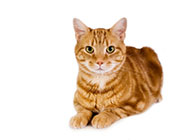
MONDAY, Nov. 10, 2014 (HealthDay News) — Millions of Americans gladly offer their house cats free food, affection and a life of ease. Now, a new investigation of feline DNA suggests why.
“Cats, unlike dogs, are really only semi-domesticated,” study senior author Wes Warren, associate professor of genetics at The Genome Institute at Washington University in St. Louis, pointed out in a university news release.
According to the researchers, cats and humans have cohabited for about 9,000 years. However, that’s still a lot less time than the estimated 30,000 years that people and dogs have been together.
In fact, “cats only recently split off from wild cats, and some even still breed with their wild relatives,” said Warren. “So we were surprised to find DNA evidence of their domestication.”
In their study, Warren’s group compared the genomes — the genetic blueprints — of domestic and wild cats.
The initial goal in sequencing the domestic cat’s genome was to study certain genetic diseases in cats that are similar to those in people, including neurological disorders and infectious and metabolic diseases. For this purpose, scientists mapped the genome of a female Abyssinian cat named Cinnamon, whose lineage could be traced back several generations.
However, to learn more about just how cats were domesticated, Warren’s team mapped the genomes of a wider array of certain purebred cats.
They identified key regions of the house cat’s genome that appeared to diverge significantly from those of wild cats. These regions are involved in behaviors such as memory, fear and reward-seeking — all of which are believed to play a role in domestication.
“Humans most likely welcomed cats because they controlled rodents that consumed their grain harvests,” Warren said. “We hypothesized that humans would offer cats food as a reward to stick around.”
So, many of these formerly wild cats understood that they were on to a sweet deal — and decided to pair up with humans. As time went on, people also began to prefer cats that were naturally more docile, Warren’s team added.
The variety of today’s domestic cats is due to humans’ breeding them for specific hair colors and patterns, the authors noted.
The findings were published Nov. 10 in the journal Proceedings of the National Academy of Sciences.
More information
The Cat Fanciers Association has more about cats.
Copyright © 2025 HealthDay. All rights reserved.

